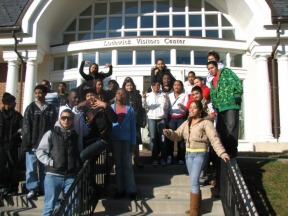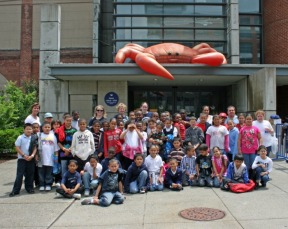School Library Media Experience
2008 - Present
I began my school library media teaching experience in the Bridgeport Public School System under the Durational Shortage Program in August 2008. Under my Connecticut Initial Educator Teaching Certificate, I began my second year of teaching information literacy skills at Barnum School to our community of at-risk, urban students in grades kindergarten through eighth grade. I was privileged to have the opportunity to build a school library media program in an expansive new library, the school having recently relocated from a hundred year old building. Providing an even greater opportunity was the relationship that my school had with the University of Connecticut's NEAG School of Education. Barnum School had been selected as one of only eight schools within Connecticut to work with the NEAG School of Education to redesign urban education. Our school became known as a CommPACT school; as such, we are guided by the principle that all members of the school community: parents, administrators, children and teachers must be involved in designing an education program which engages and motivates students to higher levels of achievement. I designed a presentation to unveil our thirteen CommPACT principles and values to our school community at a kick-off party on February 4, 2009.
The difficulties facing a school media specialist in this environment were nearly overwhelming. The district had no school library media curriculum, nor a director in charge of school media specialists during my first year. This resulted in the absence of professional development and an inability to share best practices with colleagues. The teaching staff at my school was inexperienced and had not yet developed an interest in collaboration with specialists. Most significantly, a lack of trust and value in the education system by many students resulted in negative attitudes, lack of motivation and severe behavior issues.
I decided early on that my teaching focus must support the acquisition of information literacy skills as taught in my library and information science and professional coursework towards my Masters of Library Science degree with School Media Certification at Southern Connecticut State University. I presented my plan of action to my principal who embraced both my interest in teaching lifelong skills and my belief that we could create a community of lifelong learners. Of critical importance was my ability to engage the students in experiences which they deemed to be authentic and relevant. I was lucky to discover two hooks to engage the students: learning to effectively use computer technology to create a product demonstrating their learning developed twenty-first century skills and captured their interest; and, connecting their investment in learning with a tangible and meaningful reward developed task commitment. I ventured into unchartered waters by introducing current software applications to students with a goal of engaging them in the educational process and committing them to their own futures. The eighth grade lesson plan on careers (below) worked so well that collaboration with the middle school teachers became an easier partnership thereafter. The next lesson plan for the middle school students collaborated with content area teachers and integrated information literacy skills and technology skills with curriculum topics. For the seventh grade students, a project researching endangered animals resulted in a newsletter prepared in Microsoft Publisher, and, for the eighth grade, a three-fold travel brochure of Washington, D.C. prepared them to experience the history of our government in preparation of a three day class trip.
The difficulties facing a school media specialist in this environment were nearly overwhelming. The district had no school library media curriculum, nor a director in charge of school media specialists during my first year. This resulted in the absence of professional development and an inability to share best practices with colleagues. The teaching staff at my school was inexperienced and had not yet developed an interest in collaboration with specialists. Most significantly, a lack of trust and value in the education system by many students resulted in negative attitudes, lack of motivation and severe behavior issues.
I decided early on that my teaching focus must support the acquisition of information literacy skills as taught in my library and information science and professional coursework towards my Masters of Library Science degree with School Media Certification at Southern Connecticut State University. I presented my plan of action to my principal who embraced both my interest in teaching lifelong skills and my belief that we could create a community of lifelong learners. Of critical importance was my ability to engage the students in experiences which they deemed to be authentic and relevant. I was lucky to discover two hooks to engage the students: learning to effectively use computer technology to create a product demonstrating their learning developed twenty-first century skills and captured their interest; and, connecting their investment in learning with a tangible and meaningful reward developed task commitment. I ventured into unchartered waters by introducing current software applications to students with a goal of engaging them in the educational process and committing them to their own futures. The eighth grade lesson plan on careers (below) worked so well that collaboration with the middle school teachers became an easier partnership thereafter. The next lesson plan for the middle school students collaborated with content area teachers and integrated information literacy skills and technology skills with curriculum topics. For the seventh grade students, a project researching endangered animals resulted in a newsletter prepared in Microsoft Publisher, and, for the eighth grade, a three-fold travel brochure of Washington, D.C. prepared them to experience the history of our government in preparation of a three day class trip.
Eighth Grade Career Lesson Plan "Learning to Earning"

A successful career research project became a valuable life experience for my eighth grade students as they were required to create a vision for their futures. I integrated information literacy skills with the authentic experience of looking at career opportunities with a particular emphasis on the investment that each student would need to make in their education. The final product required extensive knowledge of Microsoft Word and Word Art in the creation of posterboards depicting a description of the student's career choice, educational requirements, salary expectations and benefits and opportunities for advancement. I arranged for community professionals to address the students during a Career Day event. The students were required to gather information on each career presented and decide whether the information presented met their expectations and increased or decreased their own interest in pursuing this career path. The students who fulfilled the project requirements were provided an enrichment opportunity of visiting the University of Connecticut for a day long tour. An overview of the program is summarized in a powerpoint presentation, CommPACT Barnum School 2010, which supports the successful relationship that my school has developed with its stakeholders under the CommPACT initiative.
Third Grade Lesson Plan on Animal Habitats and Adaptations

Collaborating with third grade content area teachers, we embarked on a comparative study of animal habitats and adaptations. A wonderful opportunity availed itself in an exhibit of African penguins and the showing of the IMAX film "Wild Africa" at the Maritime Aquarium in Norwalk, CT. I introduced the Big 6 research skills to the students in the context of comparing habitats and adaptations of various animal species. The research unit culminated with a field trip to the Maritime Aquarium to observe several species in our study first hand.
Beyond the world of lesson plans and meeting curriculum needs, I believed that the school media center should provide a place for students to feel recognized and valued. During my DSAP year, I created an instructional design unit on the process of teaching sixth grade students to assist in the check out process in a school media center. This instructional unit was put to practical use in my school media center as I trained a dozen students to perform this function during heavy traffic periods. I succeeded in developing a strong relationship with those students who felt rewarded by the opportunity to work productively alongside a mentor.
In addition to rewarding task commitment in curriculum areas, I believed that students should be rewarded with extracurricular activities which supported literacy skills. I began a school newspaper as a program to engage and motivate higher performing students and build a stronger school culture. Students brainstormed the ideas for stories, completed the assignments, and applied their knowledge of software applications to create the school's first newspaper. The value of this collective effort went beyond this small group. The entire school embraced the efforts of their schoolmates by enthusiastically reading the news involving members of their school.
In addition to rewarding task commitment in curriculum areas, I believed that students should be rewarded with extracurricular activities which supported literacy skills. I began a school newspaper as a program to engage and motivate higher performing students and build a stronger school culture. Students brainstormed the ideas for stories, completed the assignments, and applied their knowledge of software applications to create the school's first newspaper. The value of this collective effort went beyond this small group. The entire school embraced the efforts of their schoolmates by enthusiastically reading the news involving members of their school.